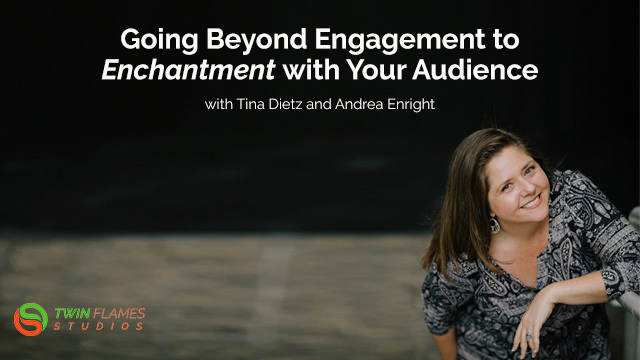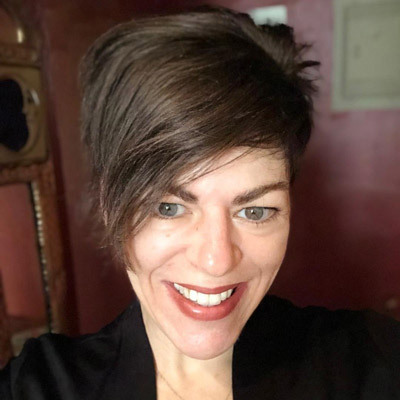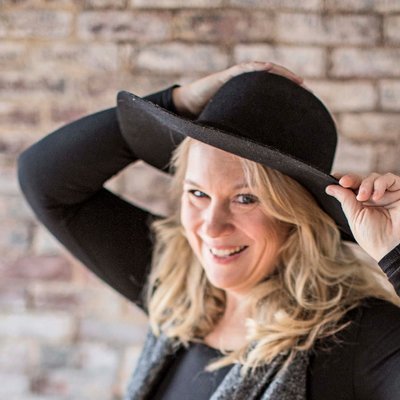How to Enchant Your Skeptical Audience and Bring Them Back for MORE
Tina Dietz talks to Andrea Enright about the importance of not just engaging, but enchanting, your audience.(Facebook Live, August 11, 2020)
Tina Dietz talks to Andrea Enright about the importance of not just engaging, but enchanting, your audience. They discuss:
- How “engagement” has become a social media buzzword
- How it’s vital to make people understand what you provide, not just what you do
- The importance of being authentic
- Tips for improving your profile and presence on LinkedIn
- The value of stories for creating enchantment—but avoiding the “Once upon a time” trope!
Listen below:
Hey everybody!
Since I'm posting this publicly, I'll introduce myself really quickly. And then of course, my beautiful friend and colleague here.
So those of you don't know me, I'm Tina Dietz, I'm the owner and CEO of Twin Flames Studios. I have been building businesses for many decades internationally, but what me and my company do best is unleash the voices of trusted brands and companies, executives, and leaders worldwide. We do that primarily through audiobooks, podcasting, and vocal leadership.
I've decided to go ahead and talk with some of my colleagues live—we have all these conversations that happen in the background, I know all these amazing human beings who are out doing incredible work in the world and I thought, “Well, you know what, why not share some of this awesome with the world?”
This is Andrea Enright from The Boot Factor—and I'll tell you more about her in just a second—but Andrea and I had gotten to talking about the proliferation, the outrageous number of people claiming to be LinkedIn experts that is happening lately. And all the mistakes that people make in their branding and their messaging, and how tired we are of certain conversations in the industries that we work in with consulting and coaching and service industry professionals.
We work a lot with the financial industries, and with high end consultants, with healthcare organizations—pharmaceutical—and training organizations. So you know, we have all these inside conversations; now we're bringing it back out to you and today what we're talking about primarily is the conversation around engagement: “Well you have to create an engagement on social media!”
Are you tired of that? I'm tired of this.
Buzzword, buzzword, buzzword!
It's such a buzzword right?
Let me tell you more about Andrea before we get into this. So Andrea, has been an entrepreneur since 2002. And much like myself, she has a checkered past…
Well, they's fun questions to come. That’s what we call a hook!
Love it!
But she's been working, beautifully, with coaches, with consultants, a lot of folks coming out of the corporate world becoming consultants, and helping them to clarify their message—”Please god, clarify your message”—and get your message out there, in these badass elevator pitches, making sure that your LinkedIn profile is, I'm gonna use a really horrible term, “on fleek.”
But making sure that it is beautiful and pristine and represents exactly who you are. We'll talk a little bit more about how that gets done. Because that is an art and a science. And she's just a really cool person to hang out with. I love her because she's no BS. That's what we're mostly talking about here.
So, thank you for joining me here today. We were having some technical issues with Facebook Live, so thanks for hanging with me through that.
Thanks, Tina!
Yeah. Sorry, do you want me to—should I talk about—
No! Talk. Absolutely! Go ahead. I'd love to have you go and dive in. I'm curious, what did I miss?
I mean… I really work with coaches and executives, and really helping people get brave with their brand, basically. When you get brave, then you get to something called, what I'm starting to call, “Leads In,” which is getting Lead Gen without freaking out, you know?
Yes!
Without the panic! So, if you can get to your authentic self, and you can get brave, and you can show up and get vulnerable and show just a little bit of lack of perfection because nobody wants to see that—we're totally bored with it. We're not interested in a long list of achievements.
And I think… Here, how about this? This is really what it sums up—most LinkedIn profiles start out with, like, “I'm not sure how to tell you this, but I'm kind of a big deal.” Right?
Yeah, actually, mine does. I know mine’s up for an evaluation. That's one of the reasons you and I have been talking And I haven't updated it yet. Because I'm intending to have your badassery all over it! So, that was the way it got done.
And it's the same way with webinars and things like that, you know? Speaking from my own experience: I've had to talk to a number of clients in the vocal leadership side of things to please, please, please tell a human story. Don't spend twenty minutes talking about your long list of how perfect your life is before you actually teach anything or share anything or give people any value about why they're there.
Right! To give people credit—to not totally throw everyone under the bus—LinkedIn was set up originally as like this resume place, right? Like this job seeking place. So people are like, “Oh my gosh, I better put everything that's amazing about me in a long boring list, like a play-by-play timeline of your life.” And guess what? Nobody cares!
Yep.
Just please summarize for me, because I'm not getting past the third line.
Yeah, and that's it. Our attention spans are like that of a gnat, pretty much, online these days. And, well, here's what here's one of my other favorites: I'm sorry, guys. We're not trying to totally throw you on the bus here. If you have any of these things, it's okay. We're all human. It's a good time. But you know, how about how about this? This pose!
It's true! I think people get really self conscious about “How am I supposed to look?” It can be okay. If you're looking authentic, if your teeth are showing, if you're smiling, if your face is taking 60% of the frame.
Yes—please.
Then you're good. I don't care what you're doing. But yeah, there is a pose—a perfection about it. And people are just not interested in that. And now LinkedIn is going from like resume to resource, like, “How can you be of value?”
Yes! From resume to resource! Let's talk about that. We've been doing some different things on LinkedIn this year and really doubling down on using LinkedIn.
We've been using LinkedIn a lot in the background and now it's kind of having a resurgence. I think for a long time, LinkedIn was a bit of the redheaded stepchild of the social media world, and now it's having a resurgence because so many more companies—we're business to business companies, and us marketing high-end services on Facebook does not work. Same with Twitter. Forget it.
Yes!
It's noise. It's just noise. So we've been having a lot of a tremendous engagement—hopefully enchantment, we shall see—with folks. And getting tremendous reach on our post, sometimes up to 65, 70,000 people seeing our posts! But it takes a lot of time to craft these messages, and get things out there. Fortunately, I have a fabulous team and they're really helping to repurpose content, get things out there every day on a regular basis.
But you know, where do you think people should start? Do you start with the content? Do you start with your profile? Chicken/egg.
I want to talk about the posting because I think there's a big shift that needs to happen with the posting. But the profile is really where you start. That's where you should start with anything. If you are a high-end coach, executive turn consultant, speaker, author—people are googling you, they're finding you, please start with your profile, and turn that into a resource instead of a resume.
So, how can you give a soft sell and create Thought Leadership, and give them something that they can use in their meeting today at 3 o'clock—and this is amazing! This makes them think, “Oh, wow! She knows what she's talking about,” and “Oh, wow! I'm going to call her anyway.” They're not going to go implement your shit with this “three tips” that you give them. If they're serious, they're gonna call you. So this is really just—it's giving. It's giving stuff away and being okay with that. It's serving instead of selling.
Serving instead of selling. That really is the key, and I think that it's also important if that feels like a foreign concept for people. Because every so often, most of the people that we work with are heavily service-oriented, heavily relationship-oriented. They're used to doing a lot of business what we would call “belly-to-belly.” But I think a lot of folks have a difficulty translating that to online, particularly our podcasting clients.
We work with a lot of folks who are very high touch, very white glove, wealth managers and consultants, who really spend a lot of time cultivating relationships with their clients. So when you go into a social media situation, it feels sometimes to them—not only like the Wild West, but like a foreign entity, like a different language they have to speak.
We talk about being vulnerable. We talk about being authentic. But for somebody who's having these long conversations with people, how does that translate?
This has been a perfect segway because of Zoom, because of having to switch to Zoom. So, people are like “I meet my clients face to face, I can't give them this custom thing. How do I do this?” And really, I think it used to be building a LinkedIn profile to get people to know, like, and trust you—
Yes, classic.
—and that was, like Dale Carnegie. It's like, Okay, “How can I get get those people in,” right? But now it has to be these three things, I believe, these three pillars. Mine are: Translate, Educate, and Enchant.
So, we Translate that message; and the biggest way we do that is, because we're not face to face with them and we can't see, we can't go off their cues—we are not in real time—we have to Translate that message, and we have to think, “How can I think of it in terms of how they're thinking about it.” Not “how I'm thinking about selling it,” because nobody wants to be sold to. “How can I think about it in terms of them receiving it?”
What is their pain? What's keeping them up at night? What is the wound that they have that they can that they cannot get past? What is hurting? And what will then make them think of that message in a translated way. So, Translate is really that first one.
Yeah, Translate very, very important there.
And here's the other thing. You mentioned something we talk about a lot in marketing, on the marketing side of things, which is pain points. I, personally, am pretty uncomfortable with the terminology of that, and a lot of my clients are as well. So, I want to translate that piece as well. Because classically, we do talk about pain points and identifying their pain or their wounds, and things like that. I want to counteroffer something here and say, you know, it might not be something that keeps people up at night, but what's the itch they can't seem to scratch? Or what do they have questions about? What are they curious about?
It really is all about putting yourself in the other person's shoes. My clients are doing well. They're doing well for themselves. They're really out there helping other people. But if I were to talk with them and say, “You have to have a podcast or everything's going to hell,” that's never going to happen.
Okay, that is a great point, and I think pain points can matter. Two things come to mind. One is that I recently redefined for me the definition of… redefined “brave,” because “brave” used to be like, being scared and doing it anyway. Guess what? That's really not good advice for a teenager who's just about to enter—
Yeah, it's a little bit psychopathic on occasion.
Right! Like “Oh, you're afraid, but keep going!” So instead, I think it's this inner knowing or this inner voice, and I think a lot of my clients’ pain—it hurts not that bad, but they know that something's off. They know they haven't tended to something, they know there's a voice that's—that they're hearing these whispers. So, I think when you have that inner knowing, that also moves you into that brave position, and into that position where you're like, “Look, I've got a change, I've got to change something. I have to go that extra step.”
That makes total sense. I had a really important turning point in my life a couple of years ago, where I realized that I had this background mantra of “I'm fine; it'll be fine. I'm fine; it'll be fine.” That's a really good thing if you're just looking to evaluate something and truly let it go, but I realized that I had spent a lot of my life talking myself into things being fine when they weren't fine.
Right. Right.
And so, I think it's important, if you are listening to this right now, if you're watching this right now, and you hear yourself trying to talk yourself into something that “It'll be fine. It'll work out.” That is a red flag.
It's a great point, and I think that leads me to this “fear abundance.” When I'm talking to people, when I'm helping them establish their brand, and they're wanting to sell—I'm like “I'm not going to outlaw it, but let's try not to wrangle our clients, or potential clients, into a position of fear.” Like, “Oh, my God, if we don't do this, things are going to be over.”
Yes.
You don't want to instill that kind of fear. I really want to get them out of the trance of scarcity and toward a mindset of abundance, right? There is more; there can be more. You can find more. And so, I think that's important as well.
Yeah, I couldn't agree more.
So what are some of the other things that you tend to see—and we'll stick with LinkedIn for right now because it's a good focal point for us to look at—especially if we're considering that how you do one thing is how you do everything. It is a place where we're focusing on showcasing ourselves as well as our businesses: Who are you, as an individual, as a leader, as a CEO, as a consultant.
But truly, we're not looking at business pages, or company pages, the same way we tend to look at individual profiles. So what are you seeing that people are missing the mark on this?
A couple things. One is they're thinking of themselves very firmly attached to the job that they currently have. When you do that, and then that job ends, and then your life will shift. So what we have to do on LinkedIn—and with a personal brand—is really talk about yourself, and brand yourself, in a way that is connected but independent of your job, right? So then when you're moving on, when you're moving up, when you're moving over, those skills are much more easily translated.
I see people describing what they do in their job instead of what they do around their job, and for the company. So it's task oriented instead of outcome oriented. I think I’m definitely seeing that as a mistake.
That's a really important focal point, and I want to build onto what you're saying. On the podcasting side of things, we often work with folks who are emerging—in their thought leadership, in their vocal leadership, in their messaging—and we see the same thing: I have a client right now, actually, who is still so firmly ensconced in the corporate world, does a great job there, has been there for 15 years, but he has a whole other company that he's been developing on the side.
So, the dance he has to dance is in speaking broadly about who he is, what he stands for, what his values are, and—rather than a lot of how to, or any kind of pitching or things like that—and that's a that's a real mindset shift.
It really is. I've seen people do that though—you really can go from, “Well, what am I really bringing to the table on the board position I have, in my company, in my side business? Why am I valued?” Then going from there, we see that people are putting their positions. They're just treating it as a resume. Instead of a headline at the top, I see a position. It really, in my opinion, should be a headline. It should be who you help, what you actually give. Not advice; you give peace of mind. Not a massage; you give out relaxation.
Translate what you do into what people are really getting, and try to lead with that. Positions mean less than they ever have, because they hand out positions because they can't pay you more sometimes. Isn't that true? I mean, your executive title does matter, but that doesn't really tell me how you're any different from the other VP. So you can have your position, but then I want to know more. I want to really know the hard skill and the soft skill of what you're bringing to the table.
And I want to give a shout out. A lot of what I've learned is from my LinkedIn coach Ellen McLemore. She's amazing. She really has helped shift my mindset on LinkedIn, and that's been that's been huge. It is really a mindset shift.
You know, one of the things that just occurred to me is the concept of elevator pitches. Which is something you work a lot with as well?
Yeah!
How does that interact with something like LinkedIn, or does it at all?
I think it really does. You have to remember that it's all about context, so when I'm sitting next to someone on a plane (in my non-COVID life), I need to have an elevator pitch that is a hook, and it's just enough for someone to turn their head and say, “Tell me more.” Or if I’m on a networking event, or if I'm a Zoom call.
But on a LinkedIn page, it's much different. We've got the scroll, we've got someone clicking, we've got someone distracted by their other tabs, and so we have to go in these little bits—and they're going to scan them. I do think the elevator pitch absolutely should be woven into the LinkedIn profile, but I would try to squeeze in some of those words I usually use into your headline. That's where I put them first, because that once you get into your “About” section it's a much different formula.
Yeah, I think that makes a lot of sense. So then coming back to our original topic of this idea of going from Engagement to Enchantment, what do you think are the differences between the two? We've seen a lot of engagement on things, but whether somebody leaves “enchanted” or not—
Yeah!
—Customers or clients certainly do, but what about interactions out in the world on a daily basis?
There's a few things we can do, to do this. Engagement is like, “Hey, I'm paying attention,” which is what we want everyone to do. To me it's like a bare minimum of having a conversation. “Is someone paying attention to me? Okay, I’ll keep talking,” which to be honest, I’m not super comfortable doing. If they're just gonna stand there, and keep talking just because, okay, I got their attention—I want more, and so it's just not enough.
To really create what I call “Enchantment,” we are going to take them by the hand and lead them on a journey. We are going to look them directly in the eye and create an intimate conversation. We are going to make them feel as though we are talking directly to them. We do that by getting human: by using human phrases, by really resonating with not just their head, but also their heart—
Yeah!
—and getting vulnerable. Most people are. Why this is hard, is, it’s scary to be vulnerable—people are a little afraid to put themselves out there, and they're also very afraid to be specific—to really talk to that one target audience person that you want to reach.
Right! That idea of “Well, if I niche down, I might miss someone or something.” That's another indication that your mindset may be a little less than abundant, perhaps, and that's okay. We all do this. Like we hit these walls, we hit these ceilings of everything that we do.I think this is also a really good place to remind people that you don't constantly have to be telling a deeply intimate personal story—you can just tell a story. This is the storytelling portion of things. It's not “Once upon a time…” necessarily, but this whole idea of creating intimacy, creating connection, and creating authentic, heart centered, alignment with another human being. That is, we connect with these little stories. We're all wired for stories.
I would say even that storytelling’s become such a buzzword. The problem is that not everybody's good at telling a story, and that's okay. Not everyone's a storyteller, and so one trick is to remember what you said—it doesn't have to be vulnerable.For example, in my profile, I used to say something like, “There's nothing I love more than mining you for your magic and building you a great brand.” And then I say, “Except maybe chips and salsa, but otherwise you’re number one!” It just gets a giggle, right? It's sharing something about me that's not vulnerable or secret or anything, I just like chips and salsa!
But it makes me like a human instead of a company, and people just they just respond to that!
Right, exactly. Yeah. as well. Another point in your bio, you say, you know, you speak to audiences—speak and sometimes swear, in front of audiences—I do the same thing. The little bit of human internal conversation with these little moments that create connection and create this sense of “Oh, I know you.”
Right! Like, “Oh, I know you! You're like my neighbor” or “I know you! You're like my daughter.” Like there's a resonance there. I think you really hit it too with this. There is that storytelling, but it doesn't have to be much—not “I've got to tell this long story.”
No, no. I was just working with this absolutely brilliant chiropractor. He's invented this incredible machine to help people with low back pain. He's an older gentleman, credentials out the yin-yang, and he's about to be on his first podcast.
But the question that always gets asked in the beginning of a podcast—notice I didn't ask it—is, “Tell me a little bit about yourself. Tell me what brought you to this place.” Or “Tell me about your journey?” I hate that question.
It's a lazy question on the part of the host. Sorry guys, it is, and it is boring to the audience because everyone answers it the same way. They always answer it, “Once upon a time… Well, I lived in a small town, and I grew up, and I got this degree, and I started in this job, and…” Once upon a time stories—we are programmed to go to sleep when we hear “Once upon a time!”
That's a good point!
So all we did was have him say the main thing that he spent his whole life doing: “What's the main thing that you spend your time doing? What's the main thing—the outcome they reach?” He said, “I spent my entire career reducing people's pain and suffering without drugs or surgery, and it was actually back when I was in high school as a 90-pound weakling on a football team.”
People are like, “What?” It's a 180 to tell this beautiful little story. Now he's just a dude, you're hanging out with coffee, who's telling you a story. By the end of that very short story I might add—of how he kind of discovered the possibility of chiropractic through high school injury—everyone's like, “I love you!”
It is true! The thing is you have to be aware enough. A great exercise to get you to this is just asking yourself five or ten questions that I include in my Boot Factor brain questionnaires, like, “What do you think about work? What do you believe about humans?” Just those two, right like, something's come up, right?
You can journal on that for a month.
Right! They're like writing prompts. You just have to answer those, rather than “Where was I born?”
“What do you do really well, what's most important to you?” And I like to ask little silly things like, “What's on your nightstand? What's your favorite food? What could you not live without—not your phone!” It gets into people's habits, so that's really about digging and trying to show up in just this little way on your profile.
Let's get some people hooked up here with connecting with us further. So the best place, Andrea, for everyone to reach you is at TheBootFactor.com; is that where we want people to go and check things out?
That's right! You can go there, sign up with my scheduler—it's right on the front page. If you go there and mention the Facebook Live, you'll get a 20-minute, free LinkedIn lowdown session with me. And I'm telling you, we're gonna have fun!
Oh, I've done it with you. It's very enlightening.
Yeah! I don't do anything without like having a little bit a little bit of moxie, a little bit of craziness. And you really will get some quick answers that you can check off.
Kickass! So go to The Boot Factor, literally: Go to TheBootFactor.com, schedule a 20-minute LinkedIn conversation—it really is enlightening. I've done this with Andrea and she really will kick your ass in the most beautiful and loving way. And you need that—I know you know you need that.And if you want to connect further with me and with Twin Flames Studios go to TwinFlamesStudios.com and check out what we do there. Check out our audio library of podcasts and audiobooks. Also feel free to reach out on our contact page anytime. You can find us all over the social media networks—”the internets,” as it were—under our name, because we have done the work and we show up on Google.So there it is. So hey, Andrea, thanks for joining me from… Denver today?
Yeah, Denver.
Thanks for joining me from the mountains. I am in the flat, flat land of Florida, as we have this cross continental conversation in the time of COVID. Thanks everyone for joining us!
Got questions? Leave a comment and we'll talk to y'all soon.
Yeah!
Bye!
Interested in learning more about audiobooks and howyou can be using audio inyour writing career ?

















